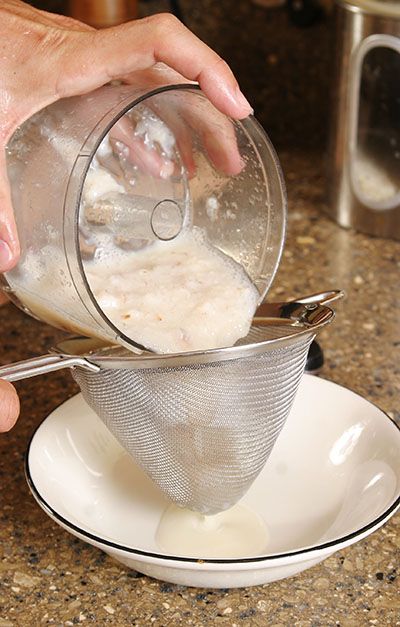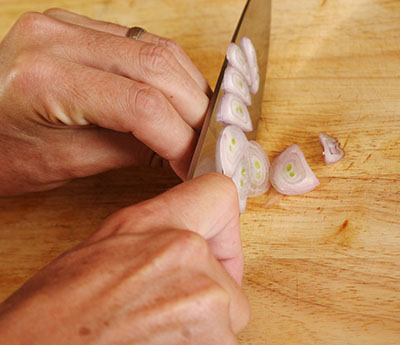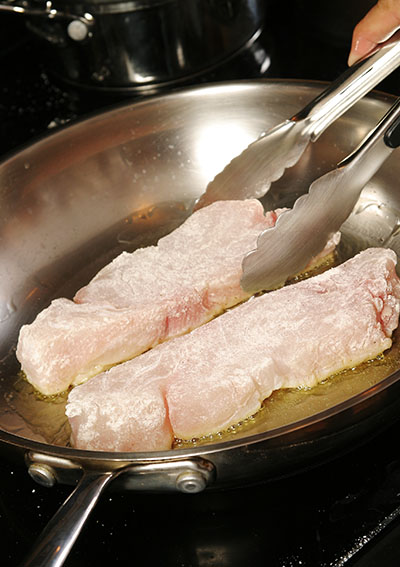Grouper with a Lychee Chile Velouté
(Read through to the end for the first FotoCuisine giveaway!) The lychee fruit is an Asian fruit, usually grown from China to India. They are commonly found canned in a syrup, and offered as desserts at a variety of Asian restaurants.
Bill Mee, from Lychees Online, runs a lychee orchard in South Florida, and he was kind enough to send us a batch of Mauritius lychees (I've since been informed that we were shipped Sweetheart Lychees -- a South Florida variety with a large fruit and small seed that is rapidly becoming a major breed) fresh from the tree. You might expect fresh, ripe lychees to be better than the canned kind, and you would be right -- there just is no comparison. The aroma, the flavor, the juiciness dripping out of every fruit, is something very unique to the Western diet.
Lychees taste like lychees, of course, but the closest flavors I can come up with are a bit of peach mixed with grape. The combination works pretty well. My 12-year old stepson doesn't like peach, but really liked the fresh lychees.
There are a lot of sweet lychee recipes, as well as savory sauces with an Indian or Asian influence. I wanted to use lychees in a savory recipe, but I wanted to do something classic in technique, mixed with Western ingredients. Since fruit always goes well with grouper (or halibut if you prefer a similar texture of fish from northern waters), I made a pan-roasted grouper with a chicken stock velouté flavored with pureed lychee and New Mexico chiles.

We got about five pounds of lychees, which is a lot of lychees. For this particular recipe, I used about a dozen of them.

I started with the chiles, however. I took four decently sized pods, and cut off the stem-ends, dumping the seeds. The chiles are put into boiling water, which is immediately taken off the heat. They soak for around 10 minutes.



While the chiles soak, I peeled the lychees. The outer rind of a lychee is similar in texture to an avocado. It's not hard to pick off the stem, and expand the torn skin, peeling the lychee like a hard-boiled egg. Except they're very slippery. A few escaped from me as I was peeling them. Sometimes, like a hard-boiled egg, there's a membrane surrounding the fruit that can be removed as well. The lychee fruit is then pulled from the seed (which is either mildly poisonous -- like peach pits -- according to one source, or they're perfectly harmless according to another source I found, but the seeds are not eaten in any case).



I put the fruit in the mini food processor and spun it around, then strained the puree through a fine-mesh strainer into a bowl. The liquid was milky, sweet, and powerfully lychee. It also had a thick consistency that reminded me a little of coconut milk. I could see how this could make an awesome curry.




By this time, the chiles were ready, so I cleaned out the food processor, and put in the chiles, along with a tablespoon or so of the rehydration liquid. Like the lychees, the puree was forced with a wooden spoon through a fine-mesh strainer into a bowl.



For the velouté, I chopped a shallot and added it to a pan with some thawed chicken stock from my freezer. I let this simmer and reduce by about a third.



One of the local fish stores had massive fillets of local grouper for sale, so I got a pound or so, which were so thick, they might as well be steaks instead of fillets. I preheated an oven to 400, dusted the steaks with flour, kosher salt, and pepper, then seared them in olive oil until browned on one side. The fish was flipped, then pan and all went into the oven to roast for 10 minutes.






While the fish roasted, I added a tablespoon or so of roux to the stock and shallots until it thickened nicely. I added the lychee puree/juice (about 1/4 cup) and whisked it in. I added two tablespoons of the chile mixture, but I tasted in between tablespoons -- I wanted the smokiness and earthiness, but I didn't want the chiles to overpower the sauce, but to lend support and a bit of contrast to the sweetness. Since chiles vary in spiciness, it's important to add a bit at a time and taste to make sure it's at the correct level. Once I was happy, I adjusted the salt a bit and added the juice of half a lemon for a little brightness, and strained out the shallots.







After the grouper roasted for 10 minutes, I let it rest for a couple, then plated it over some rice with sauce with some whole lychees as a fun garnish.

Lychee Chile Sauce (serves 2-4 depending on how much sauce you like): 4 New Mexico Chile Pods, stemmed, seeded 12 lychees, peeled and seeded 1 cup chicken stock 1 shallot, chopped 1 tablespoon hot roux kosher salt 1/2 lemon, juiced
Puree lychees in food processor and strain into bowl, pressing on the solids. Rehydrate chiles in hot water, puree in food process with some reserved water, and strain into bowl, pressing on solids. Simmer chicken stock and shallots for 15 minutes or so, until reduced by 1/3rd. Add roux and whisk. Add lychee juice and whisk. Add about 2 tablespoons of chile puree a bit at a time, tasting to make sure chiles don't overpower the sauce. Salt to taste, add lemon juice, and serve.
Deconstruction -- Okay, I nailed this one. Sweet, earthy, smokey, with the firm and mild grouper, and that great lychee taste. Dusted, roasted fish may be getting a little cliché, but that flour crust helped hold the sauce, and this was a tasty meal.
GIVEAWAY!!! One of our sponsors is A Cork Above, which offers gourmet ingredients and beverages, shipped to the US and Puerto Rico. Most shipping is included in the price. A Cork Above was kind enough to give us sample bottles (the little airline ones) of Kai Lychee Vodka. Kai Lychee is an interesting combination of rice vodka (think sake, distilled), with lychee juice added. I've tried it, and it is really unique (in a good way!). The mouth-feel is a little thick and syrupy, almost like a liqueur. It's sweet, but not overpoweringly so. The rice vodka leaves a little earthy aftertaste, similar to potato vodkas from Poland. I like it over ice, but I've also made a lychee martini with one part Kai Lychee to three parts premium vodka, shaken and strained, and it was pleasantly subtle. I used a Russian vodka, but Kai also makes a pure, unflavored rice vodka, and it would be interesting to try the combination.
We have two little airplane bottles of Kai Lychee Vodka to give away to FotoCuisine commenters. All you have to do is leave a comment between now and Monday, June 22nd at 11:59pm. We'll use a random number generator to pick two random commenters.
Fine Print: * Leave a valid email when it asks you for one, or we won't know how to contact you. * We have moderated comments turned on because we get a weird amount of spam for such a little blog. So don't worry if you don't see your comment immediately, we'll try to keep up with the moderation over the next few days. * Unfortunately for this giveaway, we have to limit it to the 50 US states and Puerto Rico. Customs sucks. * You must be over 21 and it must be legal to ship to your state from one individual to another individual.



